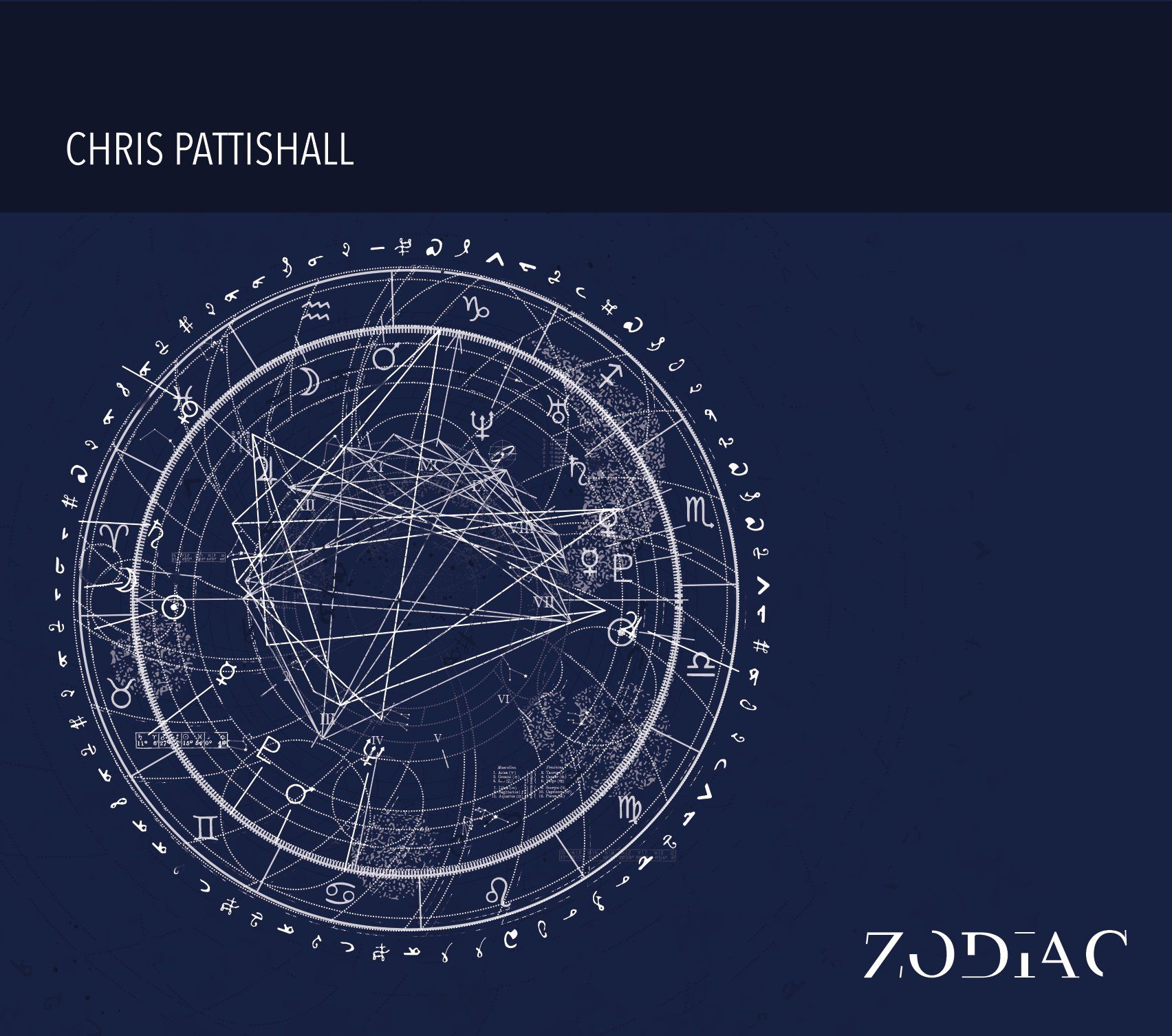PIANIST/COMPOSER/CONCEPTUALIST CHRIS PATTISHALL
OFFERS A FELLINI-ESQUE TAKE ON MARY LOU WILLIAMS’ ZODIAC SUITE
ON HIS DEBUT SOLO RECORDING
Available February 19, 2021
Featuring Rafiq Bhatia of Son Lux (producer), Jamison Ross (drums),
Riley Mulherkar (trumpet), Ruben Fox (saxophones) & Marty Jaffe (bass)
Pianist/composer Chris Pattishall’s obsession with jazz history is borne of a crate-digger’s mentality. Eschewing conservatism, the pianist and composer's work belies a fascination with how bizarre and defiant early jazz actually was. Studying with pianists Marcus Roberts and Harold Mabern gave Pattishall ample time to digest the canon of jazz piano greats, digging past the more conventional, exterior details towards deeper facets of these artists that are eclectic and provocatively irregular. In this way, Pattishall could be thought of as an erudite surrealist, influenced and following in the footsteps of writer Roberto Bolaño, filmmaker Luis Buñuel, hip-hop impresario Madlib, and the iconic Thelonious Monk. Compelled and confident to launch from jazz’s decidedly unconventional underpinnings, Pattishall is an artist who can utilize aspects of history to bend his own reality around them.
Chris Pattishall’s debut recording, Zodiac, due out on February 19, 2021 is grand, dramatic, phantasmagorical, and, like the artist himself, both studied and surreal. Pattishall, in collaboration with producer Rafiq Bhatia, and an ensemble of close allies – Jamison Ross (drums), Riley Mulherkar (trumpet), Ruben Fox (saxophone), and Marty Jaffe (bass), renders the legendary Mary Lou Williams’ futuristic early jazz compositions with both understated melodicism and Fellini-esque unreality.
When Pattishall discovered the work of Mary Lou Williams, a pioneering yet under-appreciated pianist who reached for the cosmic with the Zodiac Suite, he was immediately drawn to Williams’ sound (he later learned that she had taught and influenced Thelonious Monk), and her willingness as a composer to turn on a dime. “One of the things that drew me to this suite was how the moods change suddenly, dense narratives and allusions are presented and then suddenly give way to other fascinating ideas. It almost feels like you’ve got a remote and you’re changing channels,” Pattishall explains. “That’s a way of hearing music that I associate with Madlib and I’d never heard anyone play like that acoustically. There’s a kaleidoscopic aspect to the way that those quick changes accumulate on a larger scale. But by contrast, there are a lot of subtle things in the music that tie everything together – little gestures that keep reappearing that you might not notice if you’re not paying attention.”
As Pattishall began to transcribe Williams’ movements, he started imagining them with an expanded instrumentation in mind, and his admiration and love for her grew stronger. “She was such a brilliant arranger, and yet this piece that’s so important to me is mostly her playing solo piano. In a way I saw it as honoring this other aspect of her musicianship.” Pattishall was equally enamored with the sound of the original recording; the harmonic saturation that comes from recording to tape is a stark departure from today’s more sterilized jazz recordings. “There’s a residue that exists that is the result of the performance, but it ends up having its own hue,” he explains. Rather than attempting some sort of historical re-creation, Pattishall enlisted the help of a longtime friend in Rafiq Bhatia, who brings a creative, meticulously detailed approach to sound, which builds on the innovations of ambient and experimental electronic artists. Bhatia’s production amplifies the intimacy of the performances, while his subliminal layers of sound-design fuel the dreamlike feeling of the arrangements.
Bhatia said of producing/creating the sonic landscape of Zodiac together; "Chris has always had a fascination with the beguiling, hallucinatory, and transcendent, especially when it's hidden below the surface. He makes no exception of himself in that regard - there's a boundless and bizarre imagination beneath that studious exterior. That's a big part of what led us to become fast friends close to two decades ago, and it's central to our collaboration on Zodiac. Though the production is very active, with the sound of the ensemble subjected to near constant manipulation, we took great care to obscure the boundaries, blurring the line between where performance ends and sound design begins. We wanted to make the experience feel like a Fellini film - there's something dreamlike and strange about it all, but it's difficult to say exactly what."
Though he makes his living moonlighting as a besuited scholar of Earl Hines and Erroll Garner, you’re more likely to find Pattishall in a wolf sweatshirt when he’s off the clock, passing through the Gladstone Gallery to experience the latest from Wangechi Mutu or heading to the Armory to check out Oneohtrix Point Never. With Zodiac, Pattishall takes a step towards unifying his multifarious interests.
More on Pattishall and Zodiac:
The talents of the band are revealed in their restraint and focused rendering of Mary Lou's music. Overt virtuosic displays are replaced with a focus on intimate details and employing hushed tones throughout. Musical collaborators were selected both for their unique voices and for the resulting chemistry. For example, “Riley loves Ruben's playing and spirit, and having the two of them delivering melodies together influences them both. I also selected them to bring out things in myself, to remind me of moods and attitudes I've adopted in other settings,” says Pattishall. “We instigate when we perform together, and that owes a great bit to the amount of time we've shared on countless gigs and in rehearsals. With Zodiac, I knew I wanted to use musicians who mean something to me personally, and I think there's something true that emerges from making music with people you love.”
In addition to being sympathetic collaborators and expressive interpreters of the suite, among the musicians there is a constellation that connects Mary Lou Williams with Pattishall and his hometown of Durham, NC. Riley's mother attended Duke University and was in a choir directed and conducted by Mary Lou Williams, and bassist Marty Jaffe's uncle is composer and educator Stephen Jaffe, a professor at Duke University and a source of guidance for Pattishall's early development. “Mary Lou spent the last years of her life in Durham, teaching at Duke and impacting her local community. Early on I grabbed information from anywhere I could find it, and a lot of that came from Duke and the local scene. I see a connection in that.”
For visual inspiration, Pattishall looked deep into our collective history for images of the heavens. “I'm fascinated with how throughout history humans all over the world have looked to the heavens for lessons, or as a site to project our mythologies and morals. How we assign significance, how we describe and represent these bodies is intriguing to me.” Specifically, the interweaving geometries and use of symbols shows both a meticulous attention to detail and an incredibly vast imagination.
Using images from Johannes Kepler's 17th century cosmographic treatises and esoteric medieval Islamic grimoires as references, Pattishall enlisted visual artist Kim Alpert to construct a set of video projections, one for each movement. "When Chris approached me to design the show video program we immediately connected,” said Alpert. “After talking about what the zodiac and celestial world means to us I was reminded of the profound experience I had touring the collection of astrolabes at the Boerhaave Museum in Liden, NL. The intricate, delicate, precision and wonder of these devices juxtaposed with the personal star mapping of natal illustrations immediately identified itself as the visual language for this project. I chose graphic designer and set-maker Chris Blackwood (who has worked on some of the most ambitious and gorgeous science fiction sets in Hollywood) to illustrate a set of vector symbology and mechanical elements. His attention to detail allows for a wide selection of elements to coincide with the animations for the show, as the audience will be transported into and out of the artwork's universe. Overlaying the natal charts of Mary Lou and Chris is a visual mention of our uniqueness as individuals while also tethered into our core similarities when we embark on earthly existence. The messages speak to the temporary nature of life, as well as the balance of stoicism with the ethereal."
Chris Pattishall is an Artist In Residence at Duke University. Mary Lou Williams was Duke University's very first Artist In Residence. https://dukeperformances.duke.edu/events/chris-pattishall/




